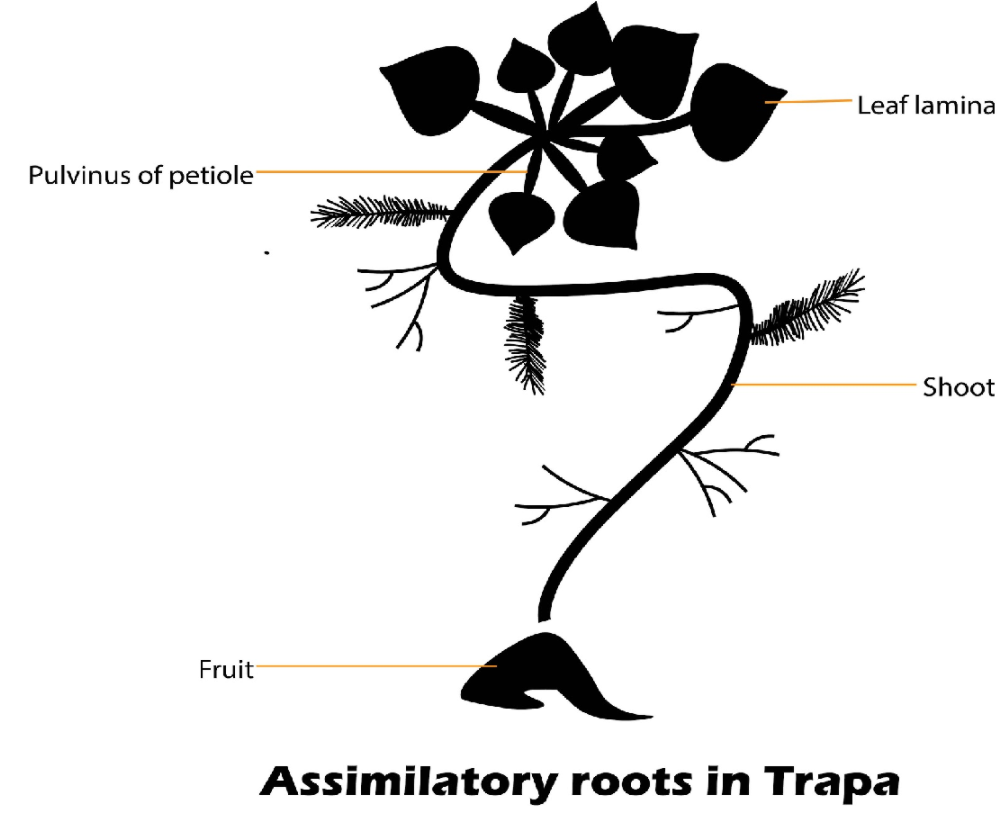
In Trapa, some of the roots are
A) Aerial
B) Assimilatory
C) Respiratory
D) Floating
Answer
486.6k+ views
Hint: They have green colored roots that are aerial, which can also perform photosynthesis and can thus prepare their food by themselves and the organisms may also sometimes extract their food from them.
Complete Answer:
Trapa is so-called as Water caltrop, and are floating annual aquatic plants. They have submerged stems that reach a length of 3.7 -4. 6 cm. These plants adhered to the mud through fine assimilatory roots. Sometimes, in a few of the plants having assimilatory roots, the stem and the leaves may be absent.
Additional information:
-The assimilatory roots are found in those plants having diverse habitats, which can be aquatic, terrestrial, and epiphytic.
-These assimilatory roots are green colored, aerial, adventitious roots.
-They prepare the food materials by the process of photosynthesis.
-The assimilatory roots are also known as photosynthetic roots.
-They are also known as reproductive roots as they help in the process of vegetative propagation.
-They synthesize carbon dioxide, water, and carbohydrates in the presence of sunlight.
-These roots have many branches which increase the surface area for the absorption of the maximum amount of sunlight to perform photosynthesis.
-These roots give support to the plants and keep them erect.
-It is commonly found in Tinospora, Traps, and Taeniophyllum.
So, the correct answer is ‘Assimilatory.’

Note: Aerial roots are those roots that are present Above the ground and are adventitious. They grow from plant stem or leaves tissue but not from the roots. Respiratory roots, also called pneumatophores, develop above the ground and have small lenticels for gaseous exchange. The floating roots are the roots that emerge from the nodes of the aquatic plants.
Complete Answer:
Trapa is so-called as Water caltrop, and are floating annual aquatic plants. They have submerged stems that reach a length of 3.7 -4. 6 cm. These plants adhered to the mud through fine assimilatory roots. Sometimes, in a few of the plants having assimilatory roots, the stem and the leaves may be absent.
Additional information:
-The assimilatory roots are found in those plants having diverse habitats, which can be aquatic, terrestrial, and epiphytic.
-These assimilatory roots are green colored, aerial, adventitious roots.
-They prepare the food materials by the process of photosynthesis.
-The assimilatory roots are also known as photosynthetic roots.
-They are also known as reproductive roots as they help in the process of vegetative propagation.
-They synthesize carbon dioxide, water, and carbohydrates in the presence of sunlight.
-These roots have many branches which increase the surface area for the absorption of the maximum amount of sunlight to perform photosynthesis.
-These roots give support to the plants and keep them erect.
-It is commonly found in Tinospora, Traps, and Taeniophyllum.
So, the correct answer is ‘Assimilatory.’

Note: Aerial roots are those roots that are present Above the ground and are adventitious. They grow from plant stem or leaves tissue but not from the roots. Respiratory roots, also called pneumatophores, develop above the ground and have small lenticels for gaseous exchange. The floating roots are the roots that emerge from the nodes of the aquatic plants.
Recently Updated Pages
The correct geometry and hybridization for XeF4 are class 11 chemistry CBSE

Water softening by Clarks process uses ACalcium bicarbonate class 11 chemistry CBSE

With reference to graphite and diamond which of the class 11 chemistry CBSE

A certain household has consumed 250 units of energy class 11 physics CBSE

The lightest metal known is A beryllium B lithium C class 11 chemistry CBSE

What is the formula mass of the iodine molecule class 11 chemistry CBSE

Trending doubts
How is phenol converted to salicylic acid class 11 chemistry CBSE

Why was the Vernacular Press Act passed by British class 11 social science CBSE

Arrange Water ethanol and phenol in increasing order class 11 chemistry CBSE

Name the nuclear plant located in Uttar Pradesh class 11 social science CBSE

One Metric ton is equal to kg A 10000 B 1000 C 100 class 11 physics CBSE

What steps did the French revolutionaries take to create class 11 social science CBSE




